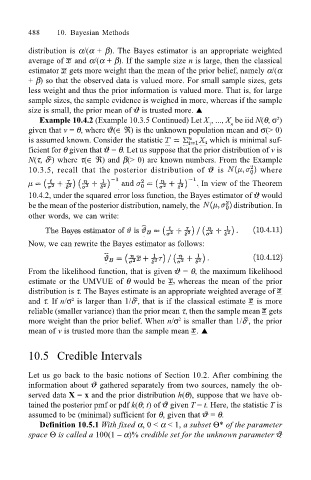Page 511 - Probability and Statistical Inference
P. 511
488 10. Bayesian Methods
distribution is α/(α + β). The Bayes estimator is an appropriate weighted
average of and α/(α + β). If the sample size n is large, then the classical
estimator gets more weight than the mean of the prior belief, namely α/(α
+ β) so that the observed data is valued more. For small sample sizes, gets
less weight and thus the prior information is valued more. That is, for large
sample sizes, the sample evidence is weighed in more, whereas if the sample
size is small, the prior mean of is trusted more. !
Example 10.4.2 (Example 10.3.5 Continued) Let X , ..., X be iid N(θ, σ )
2
1
n
given that v = θ, where (∈ ℜ) is the unknown population mean and σ(> 0)
is assumed known. Consider the statistic which is minimal suf-
ficient for θ given that = θ. Let us suppose that the prior distribution of v is
N(τ, δ ) where τ(∈ ℜ) and β(> 0) are known numbers. From the Example
2
10.3.5, recall that the posterior distribution of is where
In view of the Theorem
10.4.2, under the squared error loss function, the Bayes estimator of would
be the mean of the posterior distribution, namely, the distribution. In
other words, we can write:
Now, we can rewrite the Bayes estimator as follows:
From the likelihood function, that is given = θ, the maximum likelihood
estimate or the UMVUE of θ would be whereas the mean of the prior
distribution is τ. The Bayes estimate is an appropriate weighted average of
2
2
and τ. If n/σ is larger than 1/δ , that is if the classical estimate is more
reliable (smaller variance) than the prior mean τ, then the sample mean gets
2
more weight than the prior belief. When n/σ is smaller than 1/δ , the prior
2
mean of v is trusted more than the sample mean . !
10.5 Credible Intervals
Let us go back to the basic notions of Section 10.2. After combining the
information about gathered separately from two sources, namely the ob-
served data X = x and the prior distribution h(θ), suppose that we have ob-
tained the posterior pmf or pdf k(θ; t) of given T = t. Here, the statistic T is
assumed to be (minimal) sufficient for θ, given that = θ.
Definition 10.5.1 With fixed α, 0 < α < 1, a subset Θ* of the parameter
space Θ is called a 100(1 α)% credible set for the unknown parameter

